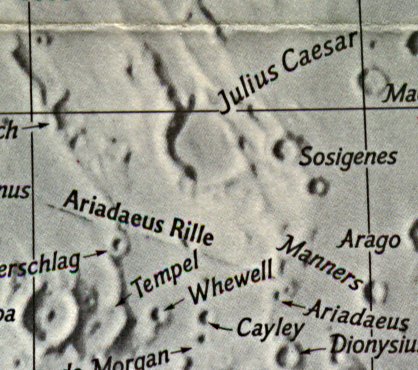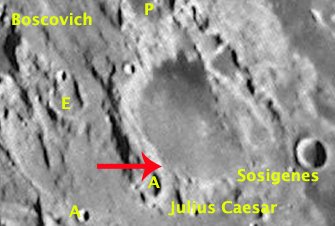

Observer: Tony Donnangelo
Date/time of observation: 2003/07/20 05:50 U.T.
Site location: Tuscarora State Forest, Camp Site #52, PA, USA
Site coordinates: N. 40°20’43.4” (40.34538°) W. 77°33’43.7” (77.56215°)
Site elevation: 482 meters (1,583feet)
Site classification: State forest wilderness area
Instrument: 14.5” Starmaster Dob.
Magnification: 267x (7mm Nagler T6)
Moon's age: 20d 11:10, illuminated 60.1%
Librations: 6.6°; N/S 4.26°; E/W 4.99°
Object: Julius Caesar
Crater size: 90x90Km (55x55Mi) Height: 3400m (10300ft)
Height/Wide ratio: 0.0378
Lunar ray coordinates: 16.0°E., 8.5° N.
Rukl chart #: 34
It was a dark and storm-less night. No clouds were available to obscure the starlight piercing down from the heavens above. The day was warm (82° F., 28° C.) but humid. The temperature dropped rapidly as the suffocating sun began to set. The night-time low of 53° F. (12° C.) in the mountain air was welcomed and refreshing. There were periods of dew, some worse than others; our telescope optics and eyepieces were spared. Air turbulence, due to the jet stream surging overhead, was most evident while observing Mars and the Moon. A speckling hint of the Milky Way, before the end of astronomical twilight, showed promise of what was to be. Pardon me if I seem over exuberant and poetically pathetic, but it was one of the best nights we had for observing in south-central Pennsylvania since last November. It was a brutal winter, a horrendous spring, and summer only shows a little sign of mercy from the sky gods.
Dave Mitsky and I traveled to one of the dark sites we utilize that’s ~1 1/2 hours drive from the Hershey area. We arrived before dark and set up our equipment and camp. We had time to eat our dinner before it got dark. We observed many deep sky objects before concentrating on Mars rising above our horizon. The Moon rose at 4:08 U.T., but didn’t clear our horizon for almost an hour. We continued to observe Mars for approximately another hour before I trained my scope on the Moon.
I began my usual routine of making a quick scan of the lunar surface for light rays. I immediately saw three light rays occurring simultaneously: one in Julius Caesar, one in Lilius, and one in Curtius (A previous light ray reported in Curtius was a sunrise ray.). A few minutes later, Dave spotted another one. It was daunting trying to observe all these light rays at once, positively identify the craters, and make an observational report. Dave had a long day, and I was still suffering from the effects of sleep deprivation from observing on a previous night. Despite our mental impairment, we thoroughly enjoyed our observations of the lunar light ray fest. Dave hadn’t observed the ray in Julius Caesar before it disappeared because of its short duration. The multiple rays, caused by high mountain peaks, Dave found in Alexander were the most interesting of the observing session.
I submitted individual reports for each of the three light rays, and Dave submitted one for his. Most of the information will be repetitive. The rays in Curtius and Lilius were almost identical, except for their size.
The eastern wall of Julius Caesar was within the shadow of the terminator. The floor was completely shadowed, except for the ray. It was a very narrow, dim, short beam of light. The ray was visible when I first started observing the moon, so would have begun some time earlier. In fact, I may have only caught the tail end of the ray, and future observations should begin much earlier than the predicted time. Within ~15 minutes, the ray completely ended. I would be interested in any future reports, due to the circumstances of my observation, to confirm that it was a ray and not illumination of some feature.
Site Longitude = +77.562
Site Latitude = +40.345
Site Elevation = +249.000
Reproducing Lighting For: 2003/7/20 at 05:50 U.T.
Desired Solar Altitude = +0.541(Setting), Azimuth = +271.314
Feature = JULIUS CAESAR
Feature Longitude: = +15.400
Feature Latitude: = +9.000
Average Co-longitude = 164.052
Moon's Altitude Restricted = Y Altitude = +5.000 degrees
In the Time column, D=Daylight, T=Twilight
---- Moon's ---- -- Earth's --
Topocentric Topocentric -------- Sun's --------
UT Date Time Alt° Semi-Diam'' Long° Lat° Colong° Lat° Azim°
2003/07/20 05:50 +18.507 901.08 +4.487 +5.235 164.271 +1.382 +271.314
Crater description from Virtual Moon Atlas: Wrecked formation of South-East North-West oriented rectangular shape. Steep slopes to the South-West and collapsed to the North-East. High walls to the South-West and damaged to the North-East. Flat floor filled with somber lava. Hills. Wrinkle ridges and craterlets. Pre-Nectarian period (From -4.55 billions years to -3.92 billions years).

